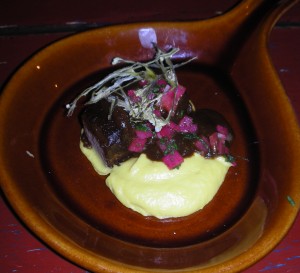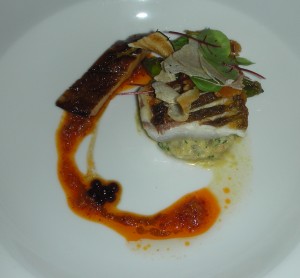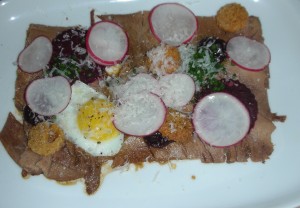


Yesterday we flew into Montreal – in and out – to meet up with a merry group and set out into the city in a luxurious and colourfully lit stretch charabanc to find our 2013 Montreal Gold Medal Plates champion. Ten first-class contenders had already emerged from the other 10 cities across the country where we had held our gala events; but how could we show up in Kelowna next February without a Montreal star? Impossible. Hence the road-trip, a “GMP plan B” that has worked very well for us before. Four of us represented GMP – our fearless leader, Stephen Leckie, our two senior Montreal judges, Lesley Chesterman and Robert Beauchemin, and me, together with World Champion short-track speed skater and three-time Olympic medallist Isabelle Charest, and many new friends from Deloitte and Impact de Montréal. We visited five very different restaurants, tasted five exceptional dishes and emerged at the end of it with a very worthy new champion.
I must say, the marks were scarily close. Kudos to the chefs, who welcomed us into their restaurants and honoured the rules we insisted upon – with one exception… Of which more later.
Our bronze medal was awarded to Nick Hodge, Texas-born chef of the ruggedly unconventional Ice House, a brilliant, casual restaurant with its roots in the southern U.S. The splendidly bearded Hodge introduced his dish as “Quebec-Mex” and served it up on an earthenware dish with a handle – very rustic and effective. The heart of his concept was local Wagyu beef brisket, cool-smoked over Texas oak wood then cooked sous vide for 72 hours. The texture he achieved by this method was remarkable – not fibrous, perfectly moist, with a crispness and firmness to the meat that met with universal appreciation. The block of beef sat on the edge of a drift of silky corn pudding, made from organic Quebec corn whipped with egg yolk, a knob of butter and a little salt until it was utterly smooth. The second sauce on the plate was in total contrast in terms of flavour, a black and intense sour cherry mole, laboured over for days and involving dried fruits, nuts, seeds, dried chilies, and – instead of using traditional but foreign-to-Canada chocolate – toasted wild elderflowers, that Chef explained had a kick just like inhaling cocoa. This sauce was amazingly deep, tangy, layered and great with the beef. The finishing touch was a garnish of fresh and pickled watermelon radish cut to the minuscule size of those tiny, worthless Sharjah postage stamps that every schoolboy collected when I was a nipper. The final flourish, the panache to the dish, lay on top – a crunchy, dehydrated, pickled, flattened okra. It was a sturdy, forthright dish with great depths of flavour in the three main components. Chef Hodge matched it with Norman Hardie’s unfiltered 2012 County Cabernet Franc, a wine that “screamed fresh cherry” to Chef Hodge and inspired the mole sauce. Like the garnishes, it contributed refreshing acidity along with its own fruity personality.
Our silver medal went to chef Antonio Park of Restaurant Park in Westmount, who also won silver last year. I have to say, his dish was exceptional – complex, technically impeccable, imaginative… Alas, there was a serious issue with the beverage he chose to accompany it. Gold Medal Plates is a celebration of Canadian excellence and we insist the chosen drink must be Canadian, whether it be a wine, beer, spirit or anything else. Chef Park paired his drink with a fine green tea from Japan brewed with brown rice. As a result we were obliged to score him a zero for Wine Compatibility, a category that commands ten percent of the total marks. We took our lead from the Olympic athletes we strive to support: break the rules of your particular discipline, and you must suffer the consequences. This in no way detracted from Chef Park’s fabulous dish which was centred around snapper. Introducing his creation to the table, Chef Park explained that he had used seven acupuncture points to numb the living fish into a state of neural oblivion before dispatching it and preparing it three ways. First there was a tartare, the raw fillet chopped and mixed with a sauce of yoghurt, ginger flowers, minced shallots, Japanese microchives, onion, carrot and Japanese plum that had been fermented for two months before being introduced to its fellow ingredients. It was a divine tartare. The second “way” was a seared fillet, still raw in the centre but lightly charred on the edge – absolutely gorgeous! The third way involved the fish’s bones, boiled down to make a broth in which to poach some yellow soshito peppers (with some three-month-old kimchee to add a touch of pep). Over to the side was a finger of seared foie gras. Did it belong with the snapper? Would, say, monkfish liver have been more à propos? Either way, the foie was totally yummy. There were many other elements in the bowl. A red sauce of pickled anchovies in wine vinegar, olive oil, garlic and ginger, spiked with a dash of Korean red pepper sauce, added serious umami. As did molecular pearls of balsamic vinegar marinated in soy sauce. As did the tissue-thin ribbons of bacon that lay on top of the fish, alongside burdock chips and shavings of white truffle. The final component, and the only heavy-handed moment on the plate, were some hard, crunchy “chips” made from deep-fried albacore tuna. Such a complex, delicious, intellectual construction! Most of our group scored it very highly indeed. If only that tea had been from Canada…
And then there was our gold-medal-winning dish, from chef Danny St-Pierre who has a restaurant called Auguste, in Sherbrooke. In order to make life easier for the judges, he had borrowed a downtown-Montreal restaurant space belonging to the Soupesoup chain, and was there to greet us and present his composition. His protein was beef tongue, sliced as thin as carpaccio and arranged into a rectangle on the plate. It was incredibly soft and tender – not slimy or stringy, as tongue can be – and its flavour had been subtly boosted by an umami-crazy drizzle of balsamic, soy and Vietnamese fish sauce. Truly subtle… If he hadn’t described it, I wouldn’t have sussed it at all. Other components were strewn about on the bed of tongue. We found shaved radish, soft discs of purple beet, crispy little croutons with the diameter of nickles that had been infused with bonemarrow, chopped chives, dots of cranberry purée like warm, tangy jam spiked with five-spice flavours that reached out to the wine, some finely grated parmesan. On top of it all was a quail egg, sunny side up, its runny yolk providing the simplest but most sublime of sauces to the tongue. Chef St-Pierre found his wine first and then created the dish to match it – and what a wine! It was something I had never tasted before. From the Venice range, grown and produced in Quebec by the Carone winery, it was a lightly chilled 2011 Cabernet Severnyi (a variety normally associated with the Czech Republic) – full-bodied, fruity, intense, purple, like some civilized cousin to a Baco Noir. A really good match for this dish!
So we found our Montreal champion. And that concludes the Gold Medal Plates 2013 campaign. Eleven chefs are coming to Kelowna in February – on the same day that the Sochi Olympics open, coincidentally. After the intense three days of competition, we will be crowning our own Canadian Culinary Champion. If anyone would like to join me there, just let me know (www.jameschatto.com) and we can talk. It’s going to be AWESOME.

Gorgeous descriptions as always. Thank you James!
Thank you, Rochelle.